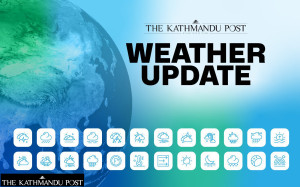Weather
Scorching heat in western Tarai makes life difficult
Hospitals in the plains of Lumbini and Sudurpaschim provinces witness a surge in patients of heat-related ailments.
Post Report
With a sudden spike in patient numbers, Seti Provincial Hospital in Kailali district has increased the number of beds in its emergency department to 38 from 21. The hospital administration said that most of the wards and units in the hospital are packed with patients, mostly those of heat-related ailments.
“Every day, over 60 diarrhoeal patients seek outpatient care in our hospital,” Kishor Prasad Shrestha, an information officer at the hospital, told the Post over the phone from Dhangadhi. “Around half a dozen patients with serious health conditions need hospitalisation.”
Along with diarrhoeal cases, the number of patients suffering from fever, food poisoning, skin disease, respiratory illness, and others has also risen at an alarming rate not only in hospitals in Dhangadhi but also in most Tarai districts of Sudurpaschim and Lumbini provinces, where the temperature has crossed 40 degrees Celsius.
“Life has become very difficult due to the sizzling temperature in our areas,” said Dr Sanket Kumar Risal, information officer at Bheri Hospital in Nepalgunj. “We, too, have increased the emergency beds’ number, and all beds in our hospital have been occupied.”
On Wednesday, the maximum temperatures in Dhangadhi and Nepalgunj exceeded 42 degrees Celsius. Health workers serving in the region said the number of patients suffering from heat stroke and heat-related ailments has increased alarmingly in recent days.
“The number of patients seeking emergency care for high-grade fever has risen significantly,” said Risal. “Patients complain that they did not have problems until the morning but suffer from high fever in the afternoon. Test shows everything normal but thermometer shows high fever.”
Due to the shortage of beds, doctors at the hospital refer a dozen patients to private centres. The number of patients of diarrhoeal ailments has also risen at Bheri Hospital, doctors say.
Doctors at Lumbini Provincial Hospital said that due to the heat wave, health facilities are experiencing an uptick in cases of diarrhoea, vomiting, urinary infections, fever, dehydration, and heat stroke, among other ailments.
“Around 20 patients who suffered nausea due to the excessive heat seek emergency care in our hospital every day,” said Dr Shiva Kunwar, chief of the emergency department. “We have been treating two patients on a single bed in the red area due to the rise in patient numbers.”
Schools in the most affected districts, including Kailali, have been shut down.
The Meteorological Forecasting Division of the Department of Hydrology and Meteorology on Tuesday issued a three-day heat wave warning after the maximum temperature in some Tarai districts crossed 40 degrees Celsius.
Experts say a heat wave occurs when the maximum and minimum temperatures at a location are unusually high over three consecutive days. The World Health Organization says heat waves are among the most dangerous natural hazards, but they rarely receive adequate attention because their toll and destruction are not always immediately obvious.
People’s exposure to heat is increasing due to climate change. Globally, extreme temperature events are observed to be increasing in their frequency, duration and magnitude, according to the UN health body.
Met officials said that people residing in the mid-western and far-western plains will bear the heat’s brunt until Friday, as no weather system has built up to cause rainfall or bring the temperatures down.
The mercury soared to a blistering 43.3 degrees Celsius on Wednesday in Dhangadhi. Nepalgunj recorded 42.8 degrees Celsius.
According to the department, exposure to excessive heat can cause tiredness, weakness, thirst, headache, leg cramps, muscle pain, vomiting, dizziness, and fainting.
Heat-related illnesses include heat stroke, heat exhaustion, heat cramps, and heat syncope (fainting). Heat stroke is the most severe form, which requires immediate medical attention.
Officials said people should take precautions if the maximum temperature in their place exceeds 40 degrees Celsius. They advised people not to venture out of their homes in the afternoon, to take sufficient fluids and water to remain hydrated and to wear cotton clothes to avoid the adverse effects of the scorching heat.
A new report from the World Meteorological Organisation said that the impact of heat waves became more severe in Asia in 2023.
“Asia is warming faster than the global average. The warming trend has nearly doubled since the 1961-1990 period,” the report stated. “Many countries in the region experienced their hottest year on record in 2023, along with a barrage of extreme conditions from droughts and waves to floods and storms.”
According to the report, Asia remained the world’s most disaster-hit region from weather, climate and water-related hazards in 2023. Floods and storms caused the highest number of reported casualties and economic losses, according to the organisation's report, a specialised agency of the United Nations whose mandate covers weather, climate and water resources.
Nepal is one of the most vulnerable countries in the world to the climate crisis and has witnessed extreme weather events over the past decade and a half.
The average annual maximum temperature in Nepal has risen by 0.056 degrees Celsius, according to a study conducted by the Department of Hydrology and Meteorology in 2017. The study shows most districts witnessed increasing temperatures annually.




 14.12°C Kathmandu
14.12°C Kathmandu



%20(1).jpg&w=300&height=200)

